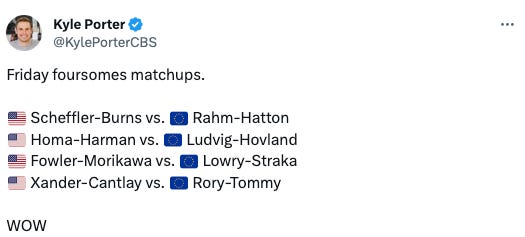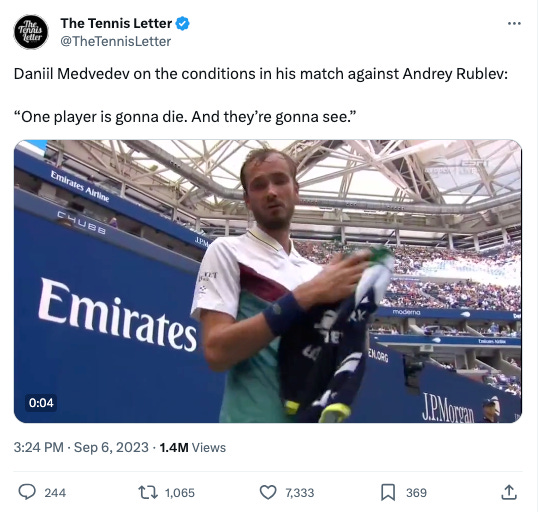The Ryder Cup
The 2023 Ryder Cup (format explained here) is nearly underway. Marco Simone, host of this year’s Ryder Cup, projects to be a golf course highly correlated with power.
Equipped with three years of advanced data from Italian Opens at Marco Simone, Team Europe somewhat controversially selected the long-hitting Nicolai Hojgaard with a captain’s pick to round out their roster. That decision signaled what Team Europe expected the golf course to reward: length.
But you don’t need to rely on bread crumbs from captain’s picks to determine which skills are required at a particular course. Instead, you can look at the characteristics of the golf course.
Marco Simone is a golf course full of long iron approach shots. Length off the tee and proficiency with long irons are positively correlated skill sets. Powerful players who hit the ball far off the tee often rank high in long iron play, in large part because they can hit less club at a higher loft into greens than their shorter-hitting competitors have to hit from the same starting point. When a golf course is full of long irons, long hitters tend to thrive.
Another crucial piece of the puzzle is that a golf course like Marco Simone is more correlated with distance than the total yardage on the scorecard suggests. Though yardage depends on which tee boxes are used, Marco Simone often plays at about 7,250 yards. There are three short Par 4s that can all be set up as drivable off the tee. Reachable Par 4s are among the most power-friendly holes in professional golf. On short Par 4s, long hitters can reach the green while shorter hitters cannot, or the longer hitter can hit 3-wood into the green while his opponents must hit driver. Either scenario presents a significant advantage, especially the former. Thus, short Par 4s are highly correlated with power.
Imagine if we replaced the three ~325-yard Par 4s with 550-yard Par 5s. Now, Marco Simone’s scorecard length would be closer to 7,900 yards. That would probably alter people’s perceptions of the golf course quite a bit even though we didn’t significantly alter the correlation with distance. That is the lens through which you should think about Marco Simone. It is a quirky, physically-demanding golf course well-suited for long-hitting players who are adept around the greens.
Pairings Strategy: Burns & Scheffler
Solving the pairings puzzle is a fascinating element of each Ryder Cup. Specifically, in the foursomes (Alternate Shot) format, teams should be thoughtful about which player tees off on the odd-numbered holes and which player tees off on the even-numbered holes. You want to partner players with a complementary skill set suitable to the golf course being played. The goal is to fit two skill sets into a superplayer: maximize the strengths of the pair while hiding its weaknesses.
At Marco Simone, the player who tees off on the odd-numbered holes will hit fewer drivers than his partner, and he will hit many more long irons. This player will hit the approach shot on three of the four Par 3s. His partner who tees off on the even-numbered holes will hit more drivers, including three on either a drivable par 4 or a par 5. Notably, this player will hit a ton of shots from around the green.
Got that? Odd-tee player hits a bunch of long irons; even-tee player hits a bunch of drivers and chips.
I’ll also add that you normally want to play your best players in the foursomes format. Within the four-balls (Best Ball) format, a bad shot is much less costly than in the foursomes format. In four-balls, when you hit a bad shot, there is a high likelihood your partner will still tie or beat the opposing team’s best ball. Your bad shots frequently won’t matter. In foursomes, when you hit a bad shot, your team is probably going to lose the hole.
Therefore, in pairing players for foursomes at Marco Simone, I’d make a concerted effort to put my best players on the course and to pair elite drivers with elite long iron players. As previously mentioned, driving and long-iron play are correlated skill sets, so it’s hard to have enough talent for all of your teams to have both an elite driver and an elite long iron player. That’s why you need as many Cameron Youngs on your team as possible, but I digress…
Anyway, that’s basically how Team Europe paired for the first session:
Take the Aberg-Hovland pairing, for example. Ludvig Aberg is one of the best drivers of the golf ball in the world. Viktor Hovland, in addition to being an excellent driver, is one of the game’s best long iron players. Hovland has made improvements to his short game recently, but his chipping is still his biggest weakness. Data on young Aberg is scarce; however, unless Team Europe has data on Aberg to suggest he’s terrible around the greens, you’ll likely see Hovland tee off on the odd holes while Aberg tees off on the even holes. This allows Aberg to maximize his driving ability and shields him from having to tee off on the intimidating first hole at his Ryder Cup debut. It also allows Hovland to hit the bulk of the approach shots while shielding him from a bunch of short game shots, his biggest weakness. That’s a strong pairing.
Team USA, on the other hand, strayed from what I consider optimal play. To best understand a mistake they are making, let’s zoom in on Sam Burns. Like every one of his teammates, Burns is a phenomenal player. His skill set is unique. Sam Burns is long and errant off the tee, and he is a tremendous wedge player and putter. He is not a good long iron player.
Wedge play and putting interact. When you hit a good wedge, you often have a 5-10 foot putt, which elite putters convert at higher rates than poor putters. Unsurprisingly, many of Sam Burns’ best results are on golf courses that put a bunch of wedges in your hand. Marco Simone is not one of those golf courses. It is a driver → long iron → chip golf course.
That’s the fundamental problem with the Scheffler-Burns pairing.
If Scheffler, the better driver, tees off on the even-numbered holes, Sam Burns will have to hit a bunch of long irons, a weakness of his. If Burns tees off on the even-numbered holes, he’ll have to hit a high number of drivers, another weakness of his. Overall it just isn’t a great pairing.
I would much have much preferred a Scheffler-Koepka pairing to start the Ryder Cup for Team USA. Let Scheffler and Burns play four-balls in the afternoon together. In four-balls, Sam Burns could stick some wedges and rack up birdies on holes that don’t play as much into Scheffler’s strengths. Scottie could hold down the fort on other holes.
I don’t want to discount the chance that Sam Burns plays well this weekend. He is a great player, and he could end up carrying the Scheffler-Burns pairing to a victory over Rahm-Hatton. Anything is possible!
Nonetheless, Marco Simone is an amazing course fit for Scottie Scheffler, and hamstringing him with a suboptimal partner could prove costly for Team USA.
The Walk
I can’t remember the exact date, but I distinctly recall betting on the New Orleans Pelicans to win an NBA game last season despite awful travel arrangements. Due to some extreme weather event, the Pelicans had to delay their travel, which resulted in their flight landing just a few hours before tip-off in the middle of a long road stint. I think it was this game in Dallas below, in which they were down 19 after the first quarter.
It was one of the stupidest bets I’ve made in the last year or so, but it drilled home an important reminder: energy levels are incredibly important in elite athletic competition. What a revelation.
If you watch the U.S. Open tennis tournament each year, you have probably observed the importance of rest. When a tennis player competes in a hot, grueling, 3.5-hour match that ends at 2:00am local time, he will be quick to mention recovery time in the post-match interview. Even with a full day off in between matches, it is difficult to recover from such a strenuous battle and show up ready to compete at the next match.
This year’s edition of the Ryder Cup will be exceptionally demanding on the athletes’ bodies. The forecast calls for hot weather in Rome, and the golf course is full of elevation changes. It is a difficult walk in a high-pressure environment. The players are going to get tired.
I anticipate the physical toll to be a significant disadvantage for Team Europe. The top of the European roster arguably has more talent. However, it is indisputable that Team USA has more talent at the bottom of the roster. Under less physically-demanding conditions, Team Europe could trot out its top talent for five matches and hide the bottom of its roster. Given the conditions they are set to face this weekend, using a top player for all five matches is less feasible.
As a captain, I’d do everything possible to give the golfers who play both the foursomes and four-balls matches on Saturday a late tee time on Sunday. Managing rest is going to be an important factor during the 2023 Ryder Cup.
Predictions
Six months ago, the betting markets gave Team USA roughly a 65% chance of winning the Ryder Cup. As we approach the opening tee shot, the competition is priced as a coin flip.
When I polled my Twitter following a couple weeks ago, I couldn’t believe the enthusiasm for Team Europe:
I think that enthusiasm has gone a little far. I don’t love most of what I’ve seen from Zach Johnson’s captaincy, especially leaving Cam Young off the roster, but the team’s talent depth is a massive advantage. The decisions made at the margins will tilt towards Europe; Team USA just has enough depth to overcome it, especially given the physical demands this week imposes. The longer the competition stays close, the better it bodes for the American side.
I think Team USA pulls this one out.
Two Closing Thoughts
Marco Simone is a high variance golf course. This increases randomness and benefits the underdog. Judge the decisions made by each side based on their process, not the (noisy) results.
I have sensed from social media that people are a little fatigued at the overanalysis of the Ryder Cup. Your fatigue is justified. Analysis paralysis is a legitimate challenge. Attempting to achieve perfection with every last pairings combination, stats consideration, or newsletter edit has diminishing returns. In my view, the sign of an intelligent decision-maker is the ability to ingest a swath of information, decide what is most important, prioritize those items, make decisions with conviction, and then go to bed. I suspect that isn’t exclusive to the Ryder Cup.
Good night.
Contact/Feedback
Email: Joseph.LaMagnaGolf@gmail.com
Twitter: @JosephLaMagna
Other Recent Content
The Shotgun Start is one of my favorite pods to join. I hopped on Monday’s episode with Andy Johnson to discuss the Solheim Cup, Norman Xiong, and Deion Sanders (Apple, Spotify)
Viktor Hovland is a delightful, authentic personality. This video is a great watch:
A video to ease you into this year’s Ryder Cup. I always appreciate Rory’s honesty and introspection:
Enjoy one of the best events in sports :)







